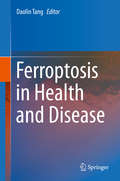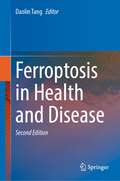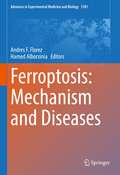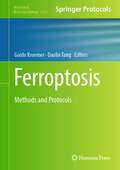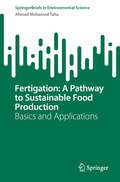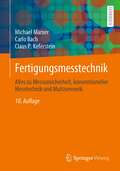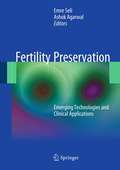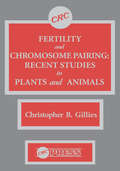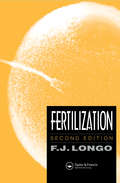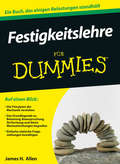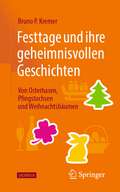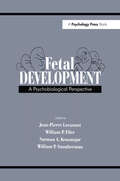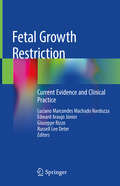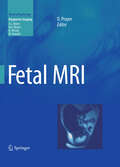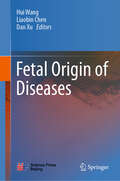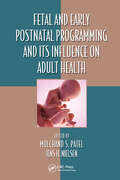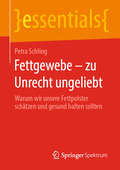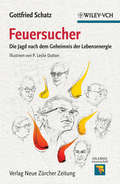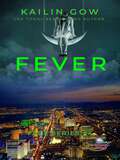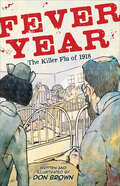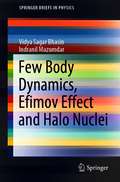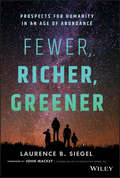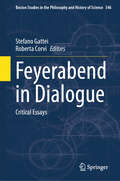- Table View
- List View
Ferroptosis in Health and Disease
by Daolin TangThis book sheds new light on ferroptosis, as an only recently recognised form of regulated cell death. Its respective chapters address the numerous implications that ferroptosis can have for virtually all aspects of metabolism. They also share insights on the morphological characterisation of ferroptosis and highlight the different pathways of induction. Accordingly, the book offers a unique perspective on a mechanism that is involved in a multitude of pathologies, including cancer cell death, neurotoxicity, neurodegenerative diseases, acute renal failure, drug-induced hepatotoxicity, tissue ischemia/reperfusion injury, and T cell immunity. Readers will learn in which cell types this form of regulated cell death is likely to occur, and how it can be pharmacologically influenced, making the book a fascinating and informative read not only for scientists working in cell biology, but also for clinicians in the field of cancer research.
Ferroptosis in Health and Disease
by Daolin TangThis updated and expanded volume gives new insights on ferroptosis – an iron-dependent form of non-apoptotic cell death. The collection of chapters discusses the two major pathways through which ferroptosis can occur: the extrinsic or transporter-dependent pathway and the intrinsic or enzyme-regulated pathway.Readers will gain an understanding of the multiple levels, on which this special cell death is regulated. Hence, the contributions will take a closer look at epigenetic, transcriptional, posttranscriptional and posttranslational layers. Among the described regulators and transcription factors are GPX4, ACSL4 and NFE2L2. This edited volume collects reviews related to current knowledge on the integrated molecular machinery of ferroptosis, thereby also describing how dysregulated ferroptosis is involved in human diseases.
Ferroptosis: Mechanism and Diseases (Advances in Experimental Medicine and Biology #1301)
by Hamed Alborzinia Andrés F. FlorezThis book focuses on the emerging role of ferroptosis in human diseases. It gives a detailed perspective on how to induce or suppress ferroptosis to treat challenging conditions such as infectious diseases, including COVID-19, tuberculosis, parasitic diseases and cancer. The book serves as a practical guide by providing a valuable collection of all currently known activators or inhibitors of ferroptosis. It will enable readers to choose molecules for experimental design for in vitro and in vivo studies of ferroptosis. Furthermore, this volume highlights the aspects of iron metabolism and its connection to ferritinophagy, a ferritin selective autophagy, with profound implications in neurodegenerative diseases such as Alzheimer, Parkinson, Huntington and ALS. Lastly, it describes necroptosis, another important form of cell death, along with its connections to human disorders and potential crosstalk with ferroptosis. While covering basic concepts, the book delves into mechanisms and modulation of ferroptosis for treating a wide variety of human diseases thus offering a valuable and informative resource for both, scientists and clinical researchers.
Ferroptosis: Methods and Protocols (Methods in Molecular Biology #2712)
by Guido Kroemer Daolin TangThis volume provides a comprehensive collection of experimental protocols for investigating ferroptosis in different systems, including cultured cells, animal models, and human tissues. The techniques covered in this book look at various aspects of ferroptosis ranging from the detection of lipid peroxidation to the measurement of glutathione peroxidase activity and the evaluation of mitochondrial morphology. Chapters also discuss basic molecular biology methods such as quantitative PCR and immunoblotting, and advanced imaging techniques such as transmission electron microscopy and confocal fluorescence microscopy. Written in the highly successful Methods in Molecular Biology series format, chapters include introductions to their respective topics, lists of the necessary materials and reagents, step-by-step, readily reproducible laboratory protocols, and tips on troubleshooting and avoiding known pitfalls.Cutting-edge and authoritative, Ferroptosis: Methods and Protocols is a valuable resource for researchers who are interested in studying ferroptosis in different contexts including basic research, drug discovery, and clinical applications.
Fertigation: Basics and Applications (SpringerBriefs in Environmental Science)
by Ahmed Mohamed TahaThis book introduces basic and practical information on fertigation to researchers, extension agents and growers. To provide understanding of the basic issues regarding the appropriate selection of fertilizer injectors, fertilizer compounds used in fertigation for growing various field and horticultural crops. The book provides useful basic principles and practical information concerning fertilizer management and fertigation techniques of field, horticulture, and medicinal and aromatic crops. The book focuses on the agronomic value of fertigation practice and provides the reader with best practical advice required for successful fertigation based on the field experience. This book summarizes the basic principles and practices of fertigation techniques to ensure accurate and efficient crop nutrition. The book consists of 5 chapters covering the following topics: Introduction to chemigation and fertigation, selecting an injector for fertilizer/chemical injection, fertilizers for fertigation, major, secondary, and micronutrient fertilizers used in fertigation, and fertigation practices: Egyptian case study. It also includes appendixes for fertigation calculation examples, calibration of an injection pump, calculating the quantities of fertilizers needed for fertigation, nutrients requirements per each ton of crop yield produced, macronutrient requirements for some filed, fiber, fruit, vegetable crops, and medicinal and aromatic plants.Fertigation is one of the smart practices that help attains sustainable food production and minimize environmental pollution. Fertigation is the application of dissolved mineral fertilizers, soil amendments, and other water-soluble products to the roots of crops through irrigation water. This book provides understanding of the basic issues regarding the appropriate selection of injectors and fertilizer compounds used in fertigation for growing various field and horticultural crops which are essential to attain higher productivity, increasing food security and reducing food contaminations. It also clarifies the advantages of fertigation and set solutions to overcome its disadvantages.
Fertigungsmesstechnik: Alles zu Messunsicherheit, konventioneller Messtechnik und Multisensorik
by Claus P. Keferstein Michael Marxer Carlo BachDieses Lehrbuch stellt praxisnah taktile und optische Messverfahren zur Erfassung geometrischer Merkmale sowie der Sichtprüfung und Defekterkennung von den Handmessmitteln bis zur Mikromesstechnik dar, ebenso relevante Teile des Qualitätsmanagements. Neu wurden die Themengebiete Digitalisierung und Verfahren der künstlichen Intelligenz und des maschinellen Lernens in einem auf die Fertigungsmesstechnik zugeschnittenen eigenen Kapitel aufgenommen.Ein ausführliches Normenverzeichnis lässt schnell gültige Standards finden. Außerdem enthalten sind Links zu Metrologie-, Normen- und Akkreditierungsinstitutionen. Ein deutsch-englisches Sachwortverzeichnis ermöglicht ein schnelles Auffinden der gesuchten Begriffe sowie die Korrespondenz mit englischsprachigen Kollegen. Das Buch eignet sich besonders gut für eine praxisgerechte Ausbildung an Hochschulen und Weiterbildungsinstitutionen. Für jeden Fertigungsbetrieb, in Konstruktion und Entwicklung sowie im Messraum und Qualitätsmanagement ist dieses Buch ein zuverlässiges Nachschlagewerk und effizienter Ratgeber.
Fertility Preservation
by Ashok Agarwal Emre SeliA growing majority of women in the western hemisphere have been delaying initiation of childbearing to later in life. Consequently, more women in their late 30s to early 40s are attempting to get pregnant for the first time than ever before. Since the incidence of most cancers increases with age, delayed childbearing results in more female cancer survivors interested in fertility preservation. In this book, the editors provide strategies for fertility preservation in women and men who require gonadotoxic treatment. In addition, epidemiologic, ethical, medico-legal, psychologic, and social aspects of fertility preservation are discussed. Using a format that combines concise scientific background with practical methodological information and easy-to-grasp algorithms, the chapters all conform to a uniform structure, including a brief abstract, keyword glossary, step by step protocol of laboratory procedures, key issues in commentary and a list of references. The result is a unique, practical reference guide for reproductive endocrinologists, urologists, embryologists, reproductive scientists, and oncologists.
Fertility and Chromosome Pairing
by Christopher Bob GilliesThis book discusses the nature of meiotic chromosome pairing effects which may play a role in the determination of fertility. In particular, data and illustrations from the application of recently developed electron microscopic spreading techniques will allow researchers in related fields to come to grips with the recent advances in the cytogenetics of meiotic chromosome pairing behavior. Topics dealt with include meiotic and synaptonemal complex behavior in humans and mice with a variety of chromosomal and genetic abnormalities, sex chromosome pairing in mammals and birds, the significance for fertility or pairing in mammals and birds, the significance for fertility of XY pairing and crossing over, the effects of hybridity on pairing and fertility in plants, and the genetic control of synaptonemal complex formation and crossing over in polyploids. This is a timely reference book for graduate level medical and veterinary students, and scientists in the field of genetics and cell biology.
Fertilization
by Frank LongoThis edition provides the reader with an introduction to this subject. During the past five years there has been a virtual explosion of information on the different phases of fertilization.This book should be of interest to advanced undergraduates and graduate students in developmental biology, zoology and cell biology; researchers entering the field.
Festigkeitslehre für Dummies (Für Dummies)
by James H. Allen IIIWenn Sie wissen müssen, was ein Bauteil aushält und was nicht, kommen Sie an der Festigkeitslehre oder Elastostatik nicht vorbei. James H. Allen hilft Ihnen hier bei Ihren ersten Schritten. Sie erfahren das Grundlegende zu Belastung, Beanspruchung, Verformung und deren Wechselwirkungen. Außerdem führt der Autor Sie ein in die Besonderheiten einzelner Materialien wie Metalle, Polymere und Keramik. So müssen Sie weder den Mohrschen Spannungskreis noch das Hooksche Gesetz fürchten und können entspannter der Festigkeitslehre gegenübertreten.
Festtage und ihre geheimnisvollen Geschichten: Von Osterhasen, Pfingstochsen und Weihnachtsbäumen
by Bruno P. KremerMit diesem Buch werden Sie Feiertage wie Ostern, Pfingsten, Weihnachten und Silvester neu entdecken. Lernen Sie in der Chronologie des Jahreslaufs eine Vielzahl kultureller und meist auch überraschender sowie kurioser Hintergründe kennen und erfahren Sie, wie die jeweiligen Jahresfeste zu ihren besonderen organismischen Begleitern bzw. Symbolträgern kamen. Thematisiert und erläutert werden beispielsweise folgende Sachverhalte:Was hat Neujahr mit Hering und Weidenrinde zu tun?Warum sind Weihrauch und Myrrhe etwas Besonderes?Welche Palmen sind am Palmsonntag dabei?Ist der Osterhase eventuell ein Kaninchen?Pfingsten und die weiße Taube – ein Verständnisfehler?Johanniskraut und die „Pille“Ein paar Hintergründe zu Jack O’Lantern und HalloweenWas hat es mit den Barbarazweigen auf sich?Wieso hat Rudi das Rentier eine rote Nase?Von den Kamelen der Heiligen Drei Könige über den Pfingstochsen bis zum Schlittengespann des Weihnachtsmannes spannt sich somit ein thematisch weiter Bogen kreuz und quer durch unsere Kulturgeschichte. Die einzelnen Kapitel lesen sich amüsant und unterhaltsam.
Fetal Development: A Psychobiological Perspective
by Jean-Pierre Lecanuet William P. Fifer Norman A. Krasnegor William P. SmothermanBased on the presentations given by well-known specialists at a recent multidisciplinary conference of developmental psychobiologists, obstetricians, and physiologists, this book is the first exhaustive attempt to synthesize the present scientific knowledge on fetal behavior. Utilizing a psychobiological analytic approach, it provides the reader with an overview of the perspectives, hypotheses, and experimental results from a group of basic scientists and clinicians who conduct research to elucidate the role of fetal behavior in development. Experimental and clinical as well as human and animal data are explored via comparative developmental analysis. The ontogeny of fetal spontaneous activity -- via the maturation of "behavioral states" -- and of fetal responsiveness to sensory stimulation is studied in detail. Results are provided from studies of embryonic/fetal and newborn behavior in chicks, rats, sheep, primates, and humans. Knowledge of fetal behavior is crucial to the obstetrician, neonatologist, developmental psychologist, and even the future parents, in order to follow and assess the gradual development of spontaneous responsive movements of the fetus. While assessing this important information, this text also examines the neuro-behavioral events taking place during the fetal period as an aid to understanding normal and pathological life span development.
Fetal Growth Restriction: Current Evidence And Clinical Practice
by Giuseppe Rizzo Edward Araujo Júnior Russell Lee Deter Luciano Marcondes NardozzaFetal growth restriction (FGR) is a condition that affects 5%–10% of all pregnancies and is the second most common cause of perinatal mortality. Fetuses with FGR present with a greater risk of long-term health defects as impaired neurological and cognitive development and cardiovascular or endocrine diseases in adulthood. Due to its high prevalence and serious long term consequences, an in-depth understating of the diagnosis and management of FGR is essential for all those professionals involved in prenatal care, since it can prevent unwanted outcomes both to the mother and to the newborn. On the last years, the knowledge about fetal growth restriction has evolved considerably, with an increasing number of articles being published on this topic and new concepts being described, including new diagnostic guidelines. Even so, there are no recent books fully dedicated to FGR; this theme has only generally been discussed in chapters in larger obstetrics and neonatology books. This current book intends to present and discuss the state of the art on FGR in a clear and didactical way. It will focus on the main topics related to FGR, including its etiology, classification, prediction, diagnosis, and management, as well as on its neurological complications and maternal cardiovascular involvement. Written by experienced and renowned gynecologists from Brazil, Italy and the US, this book will be a comprehensive guide, directed to all gynecologists, radiologists and general practitioners who are involved in prenatal care, as well as to interns, residents, professors and researchers in the field.
Fetal MRI
by Daniela Prayer Albert L. BaertThis is the most comprehensive book written on the subject of fetal MRI. It provides a practical hands-on approach to the use of state-of-the-art MRI techniques and the optimization of sequences. The book also contains numerous high-quality illustrations.
Fetal Medicine for the MRCOG and Beyond
by Alan Cameron Janet Brennand Lena Crichton Janice GibsonA solid understanding of fetal medicine is essential for the practice of obstetrics and gynaecology. This comprehensive book, which has been extensively updated to reflect current clinical practice and developments in the field since publication of the original edition, provides a thorough overview of fetal medicine, covering: screening for chromosomal abnormalities; prenatal diagnostic techniques; the routine anomaly scan; fetal structural abnormalities; fetal therapy; prenatal diagnosis and management of non-immune hydrops fetalis; termination of pregnancy for fetal abnormality; fetal growth restriction; twin pregnancy; and fetal infection. The book is primarily designed to provide a comprehensive summary for candidates preparing for the Part 2 MRCOG examination, and as such covers the RCOG curriculum for fetal medicine. It is also a valuable guide for all healthcare professionals working in the field, including trainees, consultants and midwives.
Fetal Origin of Diseases
by Dan Xu Hui Wang Liaobin ChenThis book covers two decades of the author’s studies about fetal-originated diseases. It contains researches from the aspects of multiple inducing factors of fetal-originated diseases, including prenatal xenobiotic exposure, nutritional deficiency and other adverse environment during pregnancy. The authors introduce a series of animal models for studying the fetal origin of a variety of metabolic and neuropsychiatric diseases, and propose the mechanisms of developmental toxicity and susceptibility to multiple diseases, such as glucocorticoid programming. Moreover, the extended knowledge are also clearly addressed, like identification of biomarkers of developmental toxicity, and the strategies for early warning, prevention and treatment of fetal-originated diseases. Thus, the book is a systematic and complete reference for the researchers of related areas.
Fetal and Early Postnatal Programming and its Influence on Adult Health (Oxidative Stress and Disease)
by Mulchand S. Patel Jens H. NielsenThere is a documented link between fetal nutrition and the development of disease risk in adult life. Including the early postnatal period, during which a newborn continues to grow rapidly influenced by environmental factors, suggests that individuals are subject to risks for more than just the fetal period. Fetal and Early Postnatal Programming and its Influence on Adult Health focuses on interrelated aspects of cellular programming related to early nutrition and this potential global health problem.
Fetal and Neonatal Lung Development: Clinical Correlates and Technologies for the Future
by Alan H. Jobe Jeffrey A. Whitsett Steven H. AbmanLung disease affects more than 600 million people worldwide. While some of these lung diseases have an obvious developmental component, there is growing appreciation that processes and pathways critical for normal lung development are also important for postnatal tissue homeostasis and are dysregulated in lung disease. This book provides an authoritative review of fetal and neonatal lung development and is designed to provide a diverse group of scientists, spanning the basic to clinical research spectrum, with the latest developments on the cellular and molecular mechanisms of normal lung development and injury-repair processes, and how they are dysregulated in disease. The book covers genetics, omics, and systems biology as well as new imaging techniques that are transforming studies of lung development. The reader will learn where the field of lung development has been, where it is presently, and where it is going in order to improve outcomes for patients with common and rare lung diseases. Provides an authoritative review of fetal and neonatal lung development. Designed to provide a diverse group of scientists with the latest developments on the cellular and molecular mechanisms of normal lung development and injury-repair processes. Covers genetics, omics, and systems biology as well as new imaging techniques that are transforming studies of lung development.
Fettgewebe – zu Unrecht ungeliebt: Warum wir unsere Fettpolster schätzen und gesund halten sollten (essentials)
by Petra SchlingSo wie die Feuerwehr nicht schuld ist am verheerenden Großbrand, so ist unser Fettgewebe nicht schuld an Diabetes und Herzinfarkt. Nur wenn wir unser Fettgewebe verstehen, können wir sein Potenzial erhalten und nutzen. Petra Schling gibt in diesem essential einen Überblick über Aufbau und Funktionen unseres Fettgewebes und stellt die wichtigsten Botenstoffe von Fettzellen und ihren Vorläufen vor. Darüber hinaus klärt die Autorin Irrtümer und Missverständnisse auf, die sich um das Fettgewebe ranken. Sie erläutert eine mögliche Kausalkette vom Überfluss zum Diabetes und warum das Fettgewebe zu Unrecht zum Sündenbock gemacht wird.
Feuersucher
by P. Leslie Dutton Gottfried Schatz"Feuersucher" schildert auf packende Weise, wie das Rätsel der Energieproduktion bei der Zellatmung gelöst wurde und liefert eine atmosphärische Schilderung der Forschungslandschaft im Nachkriegsösterreich und -deutschland sowie in den USA und in der Schweiz.
Fever (FADE Series #4)
by Kailin GowWinner of the IBPA Benjamin Franklin Silver Award! YA (Young Adult) - appropriate for age 16 and up. Contains non-stop action, kissing, and twists that will keep you guessing to the very end. PRAISE FOR THE FADE SERIES 5 out of 5 Stars - Kailin Gow has this talent to make the readers finish the book in a day, without a break.- Kitame 5 out of 5 Star - Lots of fresh original ideas in this book that kept me guessing. If you're looking for something different in an exciting way, get Fade. - Between the Covers "If you love the girls in Amanda Hocking's and Suzanne Collins' novels, it's time you discovered bestselling YA series author Kailin Gow!" - Steve Windwalker, #1 Amazon bestselling author and Kindle Nation Magazine founder. "It's like Nikita meets Fringe! Love it!" - On My Shelf DESCRIPTION Who had survived the Apocalypse? In Fever, the fourth book and final installment in Kailin Gow's FADE dystopian thriller series, Celes' memories return with a vengeance. Jack's memories are aligned with hers, and together they embark on fulfilling the mission they had set themselves to accomplished in their past. THE FADE SERIES BOOKS FADE Falling Forgotten Fever Series Complete!
Fever Year: The Killer Flu of 1918
by Don BrownFrom the Sibert Honor–winning creator behind The Unwanted and Drowned City comes one of the darkest episodes in American history: the Spanish Influenza epidemic of 1918. This nonfiction graphic novel explores the causes, effects, and lessons learned from a major epidemic in our past, and is the perfect tool for engaging readers of all ages, especially teens and tweens learning from home. New Year&’s Day, 1918. America has declared war on Germany and is gathering troops to fight. But there&’s something coming that is deadlier than any war. When people begin to fall ill, most Americans don&’t suspect influenza. The flu is known to be dangerous to the very old, young, or frail. But the Spanish flu is exceptionally violent. Soon, thousands of people succumb. Then tens of thousands . . . hundreds of thousands and more. Graves can&’t be dug quickly enough. What made the influenza of 1918 so exceptionally deadly—and what can modern science help us understand about this tragic episode in history? With a journalist&’s discerning eye for facts and an artist&’s instinct for true emotion, Sibert Honor recipient Don Brown sets out to answer these questions and more in Fever Year.
Few Body Dynamics, Efimov Effect and Halo Nuclei (SpringerBriefs in Physics)
by Vidya Sagar Bhasin Indranil MazumdarThis book presents an overview of the different few-body techniques developed in nuclear physics and their applications to explore the structural properties of neutron-rich unstable nuclei, the so-called halo nuclei. Formal theory of two- and three-body scattering are discussed in a compact and abridged form to initiate the beginners who want to investigate the problems of halo nuclei within the framework of three-body models. Readers gain in-depth knowledge about the methods involved to solve the two- and three-body scattering problem and a special focus is put on the Faddeev approach. In this sense, the authors address both the graduate students and senior researchers. Subsequently, a detailed analysis of the Efimov effect in three-body systems is presented and the search for the effect in atomic nuclei, both Borromean and non-Borromean is addressed. The book also presents a detailed account of how to analyze, within the framework of a 3-body approach and using realistic short range forces, the structural properties of halo nuclei. Finally, the authors discuss the recent progress in effective field theory by setting up the integral equations for 3-body scattering and applying it to study low energy scattering of neutrons off halo nuclear targets.
Fewer, Richer, Greener: Prospects for Humanity in an Age of Abundance
by Laurence B. SiegelHow the world has become much better and why optimism is abundantly justified Why do so many people fear the future? Is their concern justified, or can we look forward to greater wealth and continued improvement in the way we live? Our world seems to be experiencing stagnant economic growth, climatic deterioration, dwindling natural resources, and an unsustainable level of population growth. The world is doomed, they argue, and there are just too many problems to overcome. But is this really the case? In Fewer, Richer, Greener, author Laurence B. Siegel reveals that the world has improved—and will continue to improve—in almost every dimension imaginable. This practical yet lighthearted book makes a convincing case for having gratitude for today’s world and optimism about the bountiful world of tomorrow. Life has actually improved tremendously. We live in the safest, most prosperous time in all human history. Whatever the metric—food, health, longevity, education, conflict—it is demonstrably true that right now is the best time to be alive. The recent, dramatic slowing in global population growth continues to spread prosperity from the developed to the developing world. Technology is helping billions of people rise above levels of mere subsistence. This technology of prosperity is cumulative and rapidly improving: we use it to solve problems in ways that would have be unimaginable only a few decades ago. An optimistic antidote for pessimism and fear, this book: Helps to restore and reinforce our faith in the future Documents and explains how global changes impact our present and influence our future Discusses the costs and unforeseen consequences of some of the changes occurring in the modern world Offers engaging narrative, accurate data and research, and an in-depth look at the best books on the topic by leading thinkers Traces the history of economic progress and explores its consequences for human life around the world Fewer, Richer, Greener: Prospects for Humanity in an Age of Abundance is a must-read for anyone who wishes to regain hope for the present and wants to build a better future.
Feyerabend in Dialogue: Critical Essays (Boston Studies in the Philosophy and History of Science #346)
by Stefano Gattei Roberta CorviThis book offers innovative historical scholarship on Feyerabend’s take on topics such as realism, empiricism, pluralism, materialism, and incommensurability. In addition to discussing certain debates in the philosophy of physics, it also considers the ways in which Feyerabend’s thought can contribute to contemporary debates in science and public policy. It does so by including questions about the nature of scientific methodology, the role of science in society, the public understanding of science, scientism, and the role of expertise in public policy. The chapters provide readers with a comprehensive overview of the topics that Feyerabend engaged with throughout his career, showing both the breadth and the depth of his thought. Though of great value to academics in philosophy of science, it is also accessible and appealing to non-academic audiences with a general interest in science.
